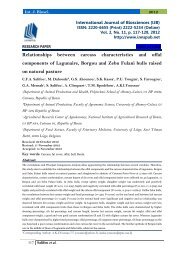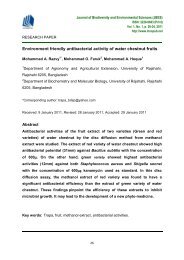Int. J. Biomol. & Biomed - International Network for Natural Sciences
Int. J. Biomol. & Biomed - International Network for Natural Sciences
Int. J. Biomol. & Biomed - International Network for Natural Sciences
Create successful ePaper yourself
Turn your PDF publications into a flip-book with our unique Google optimized e-Paper software.
20 <strong>Int</strong>. J. <strong>Biomol</strong>. & <strong>Biomed</strong>.<br />
Statistical analysis<br />
Data were expressed as means ± SEM obtained from η<br />
separate experiments. Statistical analysis and graphics<br />
were carried out using the software GraphPad Instat<br />
and GraphPad Prism 4 (San Diego, Cali<strong>for</strong>nia, USA),<br />
respectively. Statistical analysis of the results was<br />
determined by using the unpaired Student’s t-test. p <<br />
0.05 was considered as indicative of significance.<br />
Results<br />
Phytochemical analysis of S. radiatum leaves<br />
As shown in table 1, the aqueous leaf extract of S.<br />
radiatum (ESera.) used in the experimentation were<br />
composed of quinones, catechic tannins, alkaloids,<br />
sterols, terpenes, polyphenols, reducing compounds,<br />
flavonoids and saponins.<br />
Table 1. Classes of phytochemicals present in the S.<br />
radiatum leaves.<br />
Phytochemical<br />
category<br />
Leaves Extracts<br />
ESera Crude Ethanolic Hexanic<br />
Quinones + + + -<br />
Tannins Gallic - - + -<br />
Catechic + + + -<br />
Alkaloids + + + +<br />
Sterols and terpenes + + + -<br />
Polyphenols + + + -<br />
Reducing<br />
compounds<br />
+ + - -<br />
Flavonoids + + + -<br />
Saponins + + - -<br />
+ presence; - absence; ESera: S. radiatum aqueous leaf<br />
extract.<br />
Behaviour of animals in the presence of S. radiatum<br />
aqueous leaf extract<br />
The effects of low doses of Esera ranging from 24.6<br />
mg/kg b.w. to 114.2 mg/kg b.w. on the behaviour of the<br />
mice <strong>for</strong> the first ten hours were not perceptible.<br />
Beyond that, when the dose raised, some mice showed<br />
difficulties of movement.<br />
Konan et al.<br />
Esera, at high doses from 176.6 mg/kg b.w. to 575.5<br />
mg/kg b.w., induced a general modification of the<br />
behaviour of mice. Just after the administration of<br />
ESera at these doses, animals tended to gather and<br />
presented difficulties of movement with a light<br />
relaxation of the rear feet. They refused to feed. Then,<br />
after the second hour, the displacements were followed<br />
by torsion of the body and a light relaxation of the rear<br />
feet. Finally, the mice curled up in a corner and<br />
convulsed periodically. The first mice death was<br />
recorded seven hours after ESera’s application at a<br />
dose of 575.5 mg/kg b.w.<br />
Table 2. Result of acute toxicity study in mice of S.<br />
radiatum aqueous leaf extract.<br />
Groups Dose of<br />
ESera<br />
(mg/kg<br />
b.w.)<br />
Effectif<br />
of<br />
mice<br />
Mortality<br />
(%)<br />
Mortality<br />
(Probits)<br />
1 NS 10 0 1.9<br />
2 24.552 10 0 1.9<br />
3 71.846 10 10 3.71<br />
4 114.181 10 20 4.15<br />
5 176.580 10 40 4.75<br />
6 191.832 10 60 5.25<br />
7 290.333 10 60 5.25<br />
8 371.121 10 80 5.84<br />
9 391.558 10 90 6.28<br />
10 575.453 10 100 8.71<br />
Group 1 was treated with normal saline (NS) and considered<br />
as control and the other 9 groups (Group 2-10) were treated<br />
with S. radiatum aqueous leaf extract (ESera) given<br />
intraperitoneally (i.p.). The mortality rate raised in the 24<br />
hours of experimentation. The percentages of mortality were<br />
converted to probits.<br />
The mortality rate increased within 24 hours and the<br />
percentages of mortality were converted to probits<br />
(Table 2). The determination of lethal dose at 50 % of<br />
ESera was obtained by two methods:<br />
- Graphic method of Miller and Tainter (1944): After








